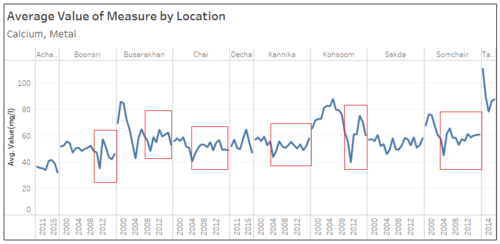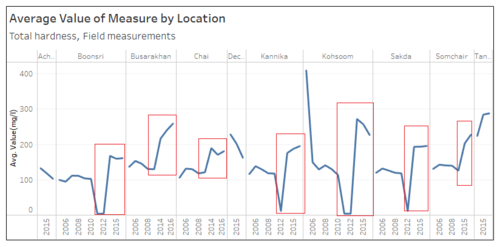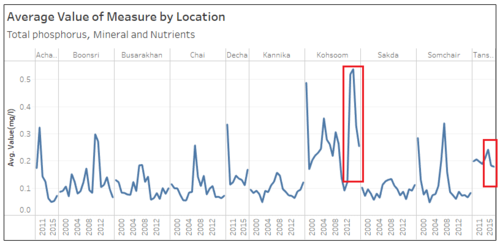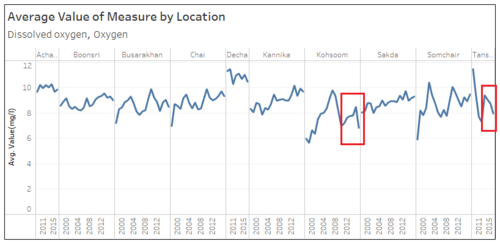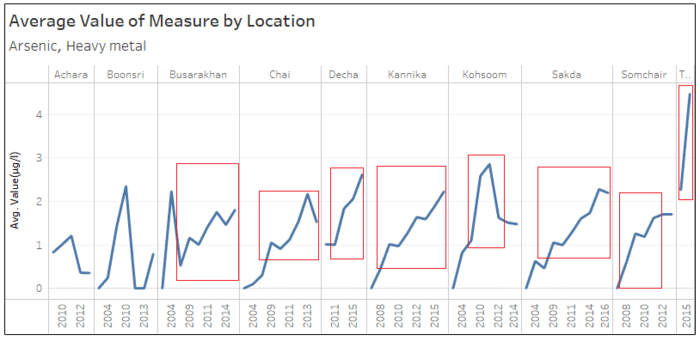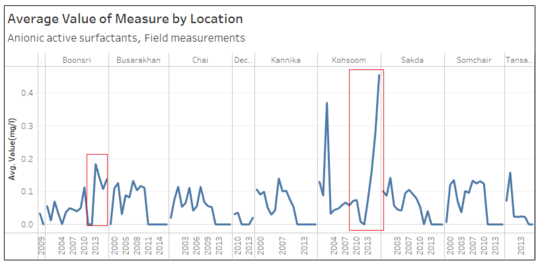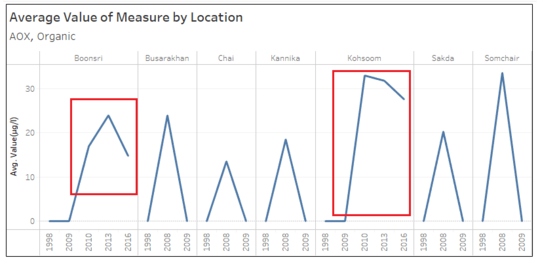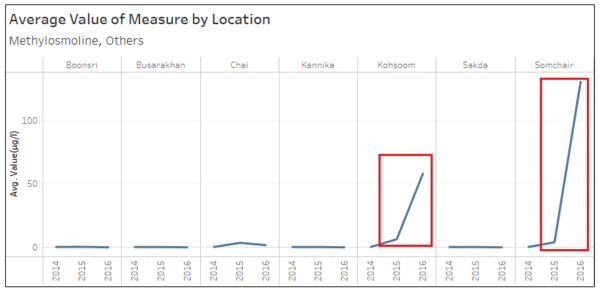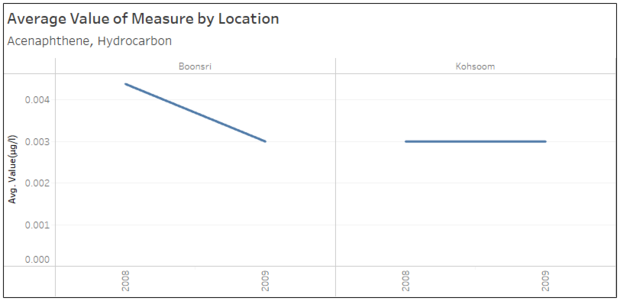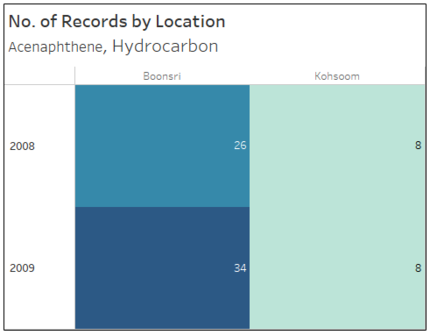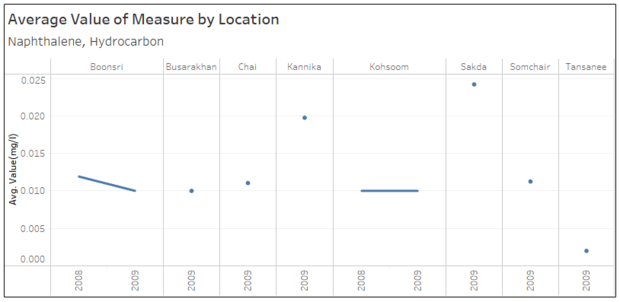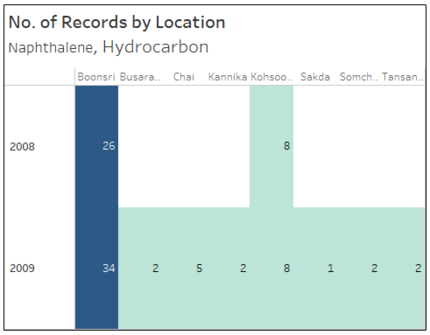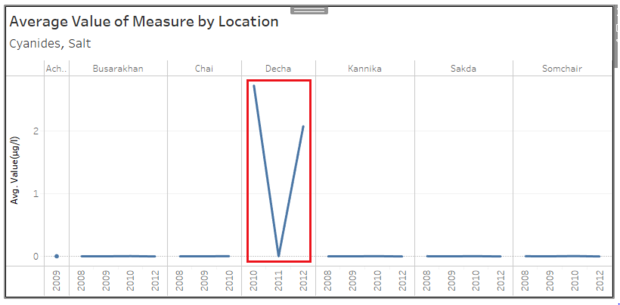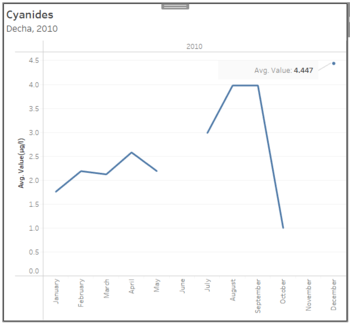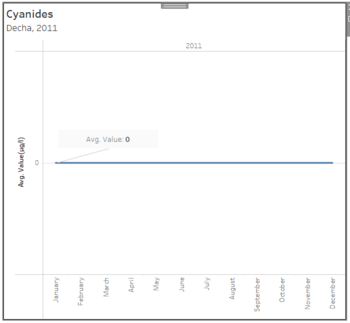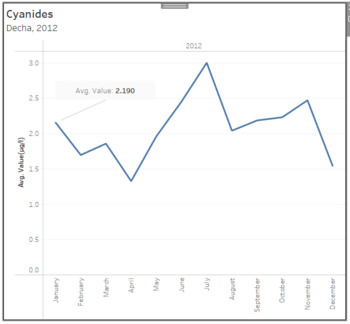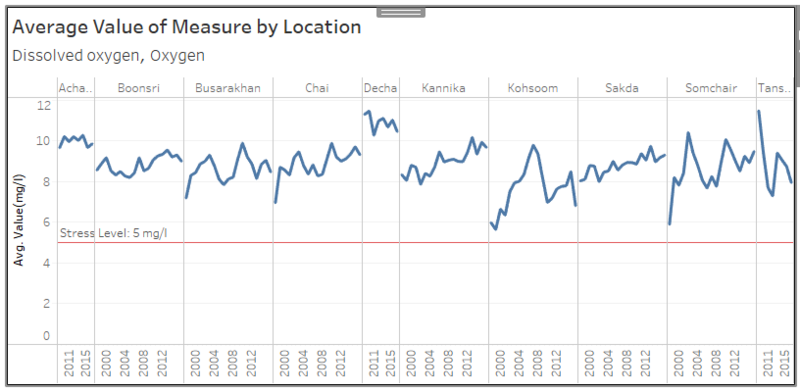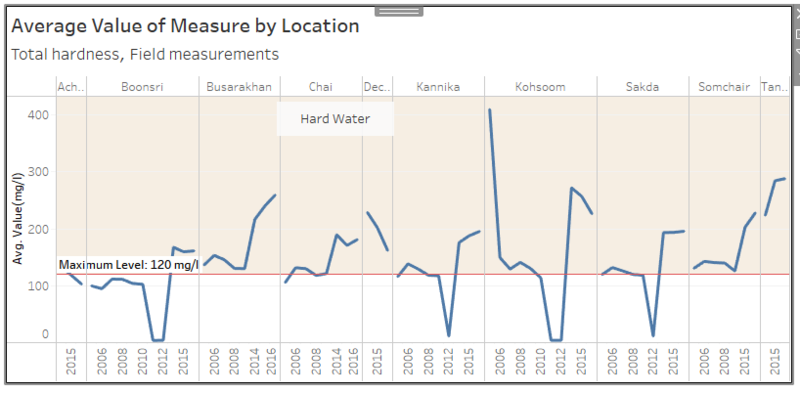Difference between revisions of "ISSS608 2017-18 T3 Assign Vaishnavi Praveen Agarwal Vast"
| (24 intermediate revisions by the same user not shown) | |||
| Line 89: | Line 89: | ||
Readings for Artificial Chemical's like <b>Anionic active surfactants</b>, <b>Adsorbable Organic Halides (AOX)</b> and <b>Methylosmoline</b> reaches peak over the last few years (2010-2016). | Readings for Artificial Chemical's like <b>Anionic active surfactants</b>, <b>Adsorbable Organic Halides (AOX)</b> and <b>Methylosmoline</b> reaches peak over the last few years (2010-2016). | ||
*<b>Anionic active surfactants</b> have increased approximately by 13% in <b>Boonsri</b> and 45% in <b>Kohsoom</b>. | *<b>Anionic active surfactants</b> have increased approximately by 13% in <b>Boonsri</b> and 45% in <b>Kohsoom</b>. | ||
| − | *<b>Adsorbable Organic Halides (AOX)</b> average value has increased from 0 (in 2009) to 27 (in 2016) in <b>Kohsoom</b> and from 0 (in 2009) to 15 (in 2016) in <b>Boonsri<b>. | + | *<b>Adsorbable Organic Halides (AOX)</b> average value has increased from 0 (in 2009) to 27 (in 2016) in <b>Kohsoom</b> and from 0 (in 2009) to 15 (in 2016) in <b>Boonsri</b>. |
*<b>Methylosmoline</b> average value has increased from 6 (in 2015) to 58 (in 2016) in <b>Kohsoom</b> and from 4 (in 2015) to 130 (in 2016) in <b>Somchair</b>. | *<b>Methylosmoline</b> average value has increased from 6 (in 2015) to 58 (in 2016) in <b>Kohsoom</b> and from 4 (in 2015) to 130 (in 2016) in <b>Somchair</b>. | ||
| + | The Artificial chemicals are results of industrial waste therefore, with this we can say that these places have high industrial waste contamination. | ||
<div style="margin:0px; padding: 2px; font-family: Arial; border-radius: 1px; text-align:left"> | <div style="margin:0px; padding: 2px; font-family: Arial; border-radius: 1px; text-align:left"> | ||
| Line 111: | Line 112: | ||
</div> | </div> | ||
| + | =<span style="color:red">Question-2(a):</span> What anomalies do you find in the waterway samples dataset? How do these affect your analysis of potential problems to the environment?= | ||
| − | + | ===1. Abnormal Data Collection Pattern for <b>Hydrocarbons</b>=== | |
| − | |||
| − | ===Abnormal Data Collection Pattern for <b>Hydrocarbons</b>=== | ||
Earlier, while preparing the data I grouped measures like Benzo(a)pyrene, Chrysene, Acenaphthene, PAH's and others as Hydrocarbons. After, grouping the data I noticed that the data recording pattern for these measures were also similar: | Earlier, while preparing the data I grouped measures like Benzo(a)pyrene, Chrysene, Acenaphthene, PAH's and others as Hydrocarbons. After, grouping the data I noticed that the data recording pattern for these measures were also similar: | ||
| Line 144: | Line 144: | ||
|} | |} | ||
</div> | </div> | ||
| + | |||
| + | ===2. Readings for Cyanide in 2011=== | ||
| + | |||
| + | The readings for <b>Cyanide</b> in <b>Decha</b> were taken only for 2010, 2011 and 2012. The visualization shows that the readings are very high in 2010 and 2012, but its 0 in 2011. For detailed analyses, I drill down to month-wise readings of each and found the following: | ||
| + | *The reading taken for December 2010 was <b>4.4 µg/l</b>. | ||
| + | *The reading for year 2011 was 0 for all the months. | ||
| + | *The reading for January 2012 was <b>2.15 µg/l</b>. | ||
| + | Based on the reading, I think the data for year 2011 was not recorded properly. | ||
| + | |||
| + | <div style="margin:0px; padding: 2px; font-family: Arial; border-radius: 1px; text-align:left"> | ||
| + | {| class="wikitable" style="background-color:#FFFFFF;" width="100%" | ||
| + | |- | ||
| + | | | ||
| + | |||
| + | <span style=text-align:center;">[[Image:Vaishnavi_Insight13.png|620px|thumb|center]]</span> | ||
| + | |||
| + | || | ||
| + | |||
| + | <span style=text-align:center;">[[Image:Vaishnavi_Insight13.1.png|350px|thumb|center]]</span> | ||
| + | |||
| + | |- | ||
| + | | | ||
| + | |||
| + | <span style=text-align:center;">[[Image:Vaishnavi_Insight13.2.png|350px|thumb|center]]</span> | ||
| + | |||
| + | || | ||
| + | |||
| + | <span style=text-align:center;">[[Image:Vaishnavi_Insight13.3.png|350px|thumb|center]]</span> | ||
| + | |||
| + | |} | ||
| + | </div> | ||
| + | |||
| + | |||
| + | =<span style="color:red">Question-2(b):</span> Is the Hydrology Department collecting sufficient data to understand the comprehensive situation across the Preserve?= | ||
| + | |||
| + | No, the data collected by Hydrology Department is not sufficient to understand the comprehensive situation across the Preserve because: | ||
| + | *Reading for a measure across places are taken for different years, places like Boonsri, Kohsoom have readings for 1998-2016, whereas places like Achara, Tansene and Deca have readings from 2009. | ||
| + | *Places like Busharakhan, Chai and Sakda do not have readings after 2010 for a few measures. | ||
| + | *The number of records for a meausre fluctuates a lot from place to place and year to year. | ||
| + | |||
| + | |||
| + | =<span style="color:red">Question-2(c):</span> What changes would you propose to make in the sampling approach to best understand the situation?= | ||
| + | |||
| + | Here are some points that could improve the data quality for Hydrology Department: | ||
| + | *The readings should be taken in fixed interval, for example: every 15 days, this will make the result more reliable and the impact of environmental factors like change in weather conditions can also be considered. | ||
| + | *The number of readings and the interval should be same for all the locations so that the concentrations can be compared across different locations. | ||
| + | *In case of drastic increase or decrease in concentration over a short period of time is noticed, the readings should be re-evaluated and possible reasons for sudden change should be noted. | ||
| + | |||
| + | |||
| + | =<span style="color:red">Question-3:</span> After reviewing the data, do any of your findings cause particular concern for the Pipit or other wildlife?= | ||
| + | |||
| + | The pipits have a cosmopolitan distribution, occurring across most of the world's land surface. They occur in most types of open habitat, although they are absent from the very driest deserts. They are mostly associated with some kind of grassland, from sea-level to alpine tundra. The diet of the pipits is dominated by small invertebrates that live near the water basin. | ||
| + | |||
| + | Following factors can be a concern for the survival of Pipit and other organisms: | ||
| + | |||
| + | ===1.Reducing Dissolved Ovygen Levels=== | ||
| + | |||
| + | [https://wiki.smu.edu.sg/1718t3isss608/ISSS608_2017-18_T3_Assign_Vaishnavi_Praveen_Agarwal_Vast#2._Inverse_Relation_between_Total_Phosporous_and_Dissolved_Oxygen Inverse Relation between Dissoved Oxygen and Total Phosphorus] as discussed in Question 1, shows that the level of Dissolved Oxygen is decreasing over time due to increase in the concentration of Phosphorous and other harmful ions in water. | ||
| + | |||
| + | Dissolved oxygen is necessary for the survival of fish, invertebrates, bacteria, and underwater plants. And the Pipit survives on these invertebrates, therefore with reduced levels of DO, the chances of survival for invertebrates are less, which is a direct threat to Pipit. | ||
| + | |||
| + | Therefore, in places like Kohsoom and Tansene where the DO level is close to the minimum level of (5 mg/l), water contamination should be controlled to protect the wildlife and existence of Pipit. | ||
| + | |||
| + | <span style=text-align:center;">[[Image:Vaishnavi_Insight14.png|800px|thumb|left]]</span> | ||
| + | |||
| + | |||
| + | <br><br><br><br><br><br><br><br><br><br><br><br><br><br><br><br><br><br> | ||
| + | <br> | ||
| + | |||
| + | ===2. Increasing Water Hardness=== | ||
| + | |||
| + | [https://wiki.smu.edu.sg/1718t3isss608/ISSS608_2017-18_T3_Assign_Vaishnavi_Praveen_Agarwal_Vast#2._Direct_Relation_between_Calcium_and_Total_Hardness Relation between Water Hardness and Presence of Calcium] as discussed in Question 1, shows that the hardness is increasing over the years due to increase in the concentration of Calcium and other ions. Also, with increase in Hardness the concentration of Dissolved Salts in water increases. | ||
| + | |||
| + | The maximum level of water hardness is 120 mg/l, values above this can cause adverse health issues to the marine life and also to birds like Pipit that breed on the water. | ||
| + | |||
| + | <span style=text-align:center;">[[Image:Vaishnavi_Insight15.png|800px|thumb|left]]</span> | ||
Latest revision as of 17:50, 8 July 2018
|
|
|
|
|
|
|
Contents
- 1 Question-1: Characterize the past and most recent situation with respect to chemical contamination in the Boonsong Lekagul waterways.
- 2 Question-2(a): What anomalies do you find in the waterway samples dataset? How do these affect your analysis of potential problems to the environment?
- 3 Question-2(b): Is the Hydrology Department collecting sufficient data to understand the comprehensive situation across the Preserve?
- 4 Question-2(c): What changes would you propose to make in the sampling approach to best understand the situation?
- 5 Question-3: After reviewing the data, do any of your findings cause particular concern for the Pipit or other wildlife?
Question-1: Characterize the past and most recent situation with respect to chemical contamination in the Boonsong Lekagul waterways.
1. Direct Relation between Calcium and Total Hardness
Water Hardness is the amount of dissolved Calcium and other metals ions in water. A good level of hardness in water is <120 mg/l. Based on the data, it is seen that the concentration of Calcium increases after 2012 in all the places. Also, the levels of Total Hardness increased in all the places after 2012. Therefore, similar trend for these two measures is seen. Also, both of these measures are high in Tansene and Kohsoom.
2. Inverse Relation between Total Phosporous and Dissolved Oxygen
Just as we need air to breathe, aquatic organisms need dissolved oxygen to respire. It is necessary for the survival of fish, invertebrates, bacteria, and underwater plants. Low dissolved oxygen (DO) primarily results from excessive algae growth caused by Phosphorus. Phosphorus is an essential element for plant life, but when there is too much of it in water, it can speed up eutrophication. The maximum level of Phosporous is 0.03 mg/l. From the graphs below, it is seen that the Total Phosphorous levels are high for Kohsoom and Tansene for the last two years as compared to other places. And, the levels of Dissolved Oxygen have decreased in these two places for the last two year, and its the least compared to other places.
3. Increase in Arsenic Concentration
The concentration level of Arsenic increased in all the places after 2009. Arsenic can enter the water supply majorly from industrial pollution. Which gives a reason to claim that the industrial waste has increased over the years.
4. Increase in Artificial Chemical's Concentration
Readings for Artificial Chemical's like Anionic active surfactants, Adsorbable Organic Halides (AOX) and Methylosmoline reaches peak over the last few years (2010-2016).
- Anionic active surfactants have increased approximately by 13% in Boonsri and 45% in Kohsoom.
- Adsorbable Organic Halides (AOX) average value has increased from 0 (in 2009) to 27 (in 2016) in Kohsoom and from 0 (in 2009) to 15 (in 2016) in Boonsri.
- Methylosmoline average value has increased from 6 (in 2015) to 58 (in 2016) in Kohsoom and from 4 (in 2015) to 130 (in 2016) in Somchair.
The Artificial chemicals are results of industrial waste therefore, with this we can say that these places have high industrial waste contamination.
Question-2(a): What anomalies do you find in the waterway samples dataset? How do these affect your analysis of potential problems to the environment?
1. Abnormal Data Collection Pattern for Hydrocarbons
Earlier, while preparing the data I grouped measures like Benzo(a)pyrene, Chrysene, Acenaphthene, PAH's and others as Hydrocarbons. After, grouping the data I noticed that the data recording pattern for these measures were also similar:
- The readings for these measures were taken only for years between 2007-2009.
- The number of readings taken in Boonsri were three times more than number of readings for any other place.
- The average value of readings was high in those years.
Because of this, I was not able to examine the trend of these measures, and cannot find if they pose any potential threat to the environment.
2. Readings for Cyanide in 2011
The readings for Cyanide in Decha were taken only for 2010, 2011 and 2012. The visualization shows that the readings are very high in 2010 and 2012, but its 0 in 2011. For detailed analyses, I drill down to month-wise readings of each and found the following:
- The reading taken for December 2010 was 4.4 µg/l.
- The reading for year 2011 was 0 for all the months.
- The reading for January 2012 was 2.15 µg/l.
Based on the reading, I think the data for year 2011 was not recorded properly.
Question-2(b): Is the Hydrology Department collecting sufficient data to understand the comprehensive situation across the Preserve?
No, the data collected by Hydrology Department is not sufficient to understand the comprehensive situation across the Preserve because:
- Reading for a measure across places are taken for different years, places like Boonsri, Kohsoom have readings for 1998-2016, whereas places like Achara, Tansene and Deca have readings from 2009.
- Places like Busharakhan, Chai and Sakda do not have readings after 2010 for a few measures.
- The number of records for a meausre fluctuates a lot from place to place and year to year.
Question-2(c): What changes would you propose to make in the sampling approach to best understand the situation?
Here are some points that could improve the data quality for Hydrology Department:
- The readings should be taken in fixed interval, for example: every 15 days, this will make the result more reliable and the impact of environmental factors like change in weather conditions can also be considered.
- The number of readings and the interval should be same for all the locations so that the concentrations can be compared across different locations.
- In case of drastic increase or decrease in concentration over a short period of time is noticed, the readings should be re-evaluated and possible reasons for sudden change should be noted.
Question-3: After reviewing the data, do any of your findings cause particular concern for the Pipit or other wildlife?
The pipits have a cosmopolitan distribution, occurring across most of the world's land surface. They occur in most types of open habitat, although they are absent from the very driest deserts. They are mostly associated with some kind of grassland, from sea-level to alpine tundra. The diet of the pipits is dominated by small invertebrates that live near the water basin.
Following factors can be a concern for the survival of Pipit and other organisms:
1.Reducing Dissolved Ovygen Levels
Inverse Relation between Dissoved Oxygen and Total Phosphorus as discussed in Question 1, shows that the level of Dissolved Oxygen is decreasing over time due to increase in the concentration of Phosphorous and other harmful ions in water.
Dissolved oxygen is necessary for the survival of fish, invertebrates, bacteria, and underwater plants. And the Pipit survives on these invertebrates, therefore with reduced levels of DO, the chances of survival for invertebrates are less, which is a direct threat to Pipit.
Therefore, in places like Kohsoom and Tansene where the DO level is close to the minimum level of (5 mg/l), water contamination should be controlled to protect the wildlife and existence of Pipit.
2. Increasing Water Hardness
Relation between Water Hardness and Presence of Calcium as discussed in Question 1, shows that the hardness is increasing over the years due to increase in the concentration of Calcium and other ions. Also, with increase in Hardness the concentration of Dissolved Salts in water increases.
The maximum level of water hardness is 120 mg/l, values above this can cause adverse health issues to the marine life and also to birds like Pipit that breed on the water.

